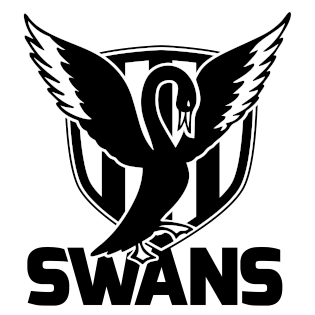Related Research Articles

The West Australian Football League is an Australian rules football league based in Perth, Western Australia. The league currently consists of ten teams, which play each other in a 20-round season usually lasting from April to September, with the top five teams playing off in a finals series, culminating in a Grand Final. The league also runs reserves, colts (under-19) and women's competitions.

The Swan Districts Football Club, nicknamed the Swans, is an Australian rules football club playing in the West Australian Football League (WAFL) and WAFL Women's (WAFLW). The club is based at Bassendean Oval, in Bassendean, an eastern suburb of Perth, Western Australia. The club was formed in 1933, and joined the then-Western Australian National Football League (WANFL) in 1934, acting as a successor to the Midland Junction Football Club, which had disbanded during World War I, in the Perth Hills region.
Raymond Cyril Scott was a leading Australian rules football player and field umpire in the West Australian National Football League (WANFL).
John Cameron Sheedy was an Australian rules footballer and coach. He played for East Fremantle and East Perth in the Western Australian National Football League (WANFL) and South Melbourne in the Victorian Football League (VFL). Sheedy is considered one of the greatest ever footballers from Western Australia, being the first player from that state to play 300 games in elite Australian rules football, and was a member of both the Australian Football Hall of Fame and the West Australian Football Halls of Fame.
Austin Christopher Robertson was an Australian rules footballer who played with South Melbourne in the Victorian Football League (VFL) and Subiaco in the Western Australian National Football League (WANFL). He was the son of South Melbourne player Austin Robertson senior.

Bernard George Andrew Naylor was an Australian rules footballer who was one of the most successful full-forwards in the history of the West Australian Football League. The WAFL now awards the leading goalscorer each year the Bernie Naylor Medal.
Raymond John Schofield was an Australian rules footballer who played with West Perth in the Western Australian National Football League (WANFL).
The 1977 WANFL season was the 93rd season of the Western Australian National Football League in its various incarnations. It followed on from the previous season's high scoring to set another record for the highest average score in WANFL history at 109.57 points per team per game, which was to be broken substantially in the following few years due to the introduction of the interchange rule allowing for a faster game with less exhausted players. 1977 was in fact that last WA(N)FL season with no score of over 200 points until 1988.
The 1975 WANFL season was the 91st season of senior Australian rules football in Perth and the forty-fifth as the “Western Australian National Football League”. The season saw West Perth, after unexpectedly falling to last in 1974, rise under former Fitzroy coach Graham Campbell to a remarkable premiership win over South Fremantle by a record 104 points in front of what was then the biggest WANFL crowd on record and has since been only exceeded by the 1979 Grand Final. The Bulldogs, apart from Claremont the least successful WANFL club between 1957 and 1974, rose with arrival of Aboriginal stars Stephen Michael and Maurice Rioli to their first finals appearance in five years and began their greatest era since their golden days of the middle 1950s. With East Perth, revitalised after injuries affected their 1974 campaign, and the inconsistent but at times incomparable Swan Districts, they comprised a top four that remained unchanged for the final fourteen rounds.
The 1973 WANFL season was the 89th season of the Western Australian National Football League. It is most famous for Subiaco breaking the longest premiership drought in the history of the competition, winning for the first time since 1924 after having been a chopping block for most of the middle third of the century. Under the coaching of former St Kilda champion Ross Smith, the Lions, as they became christened in July, bounced back from two disappointing seasons to lose only two of their final sixteen home-and-away games for their first minor premiership since 1935, then in a low-scoring Grand Final comfortably defeated a much more hardened West Perth team.
The 1942 WANFL season was the 58th season of the Western Australian National Football League. Whilst the previous two seasons had been increasingly affected by the drift of players to the services, the 1941/1942 off-season saw the Imperial Japanese Navy and air force move into the north of Western Australia, bombing many northwestern settlements.
The 1965 WANFL season was the 81st season of the various incarnations of the Western Australian National Football League.
The 1966 WANFL season was the 82nd season of the various incarnations of the Western Australian National Football League.
The 1964 WANFL season was the 80th season of the various incarnations of the Western Australian National Football League.
The 1963 WANFL season was the 79th season of the various incarnations of the Western Australian National Football League.
The 1962 WANFL season was the 78th season of the various incarnations of the Western Australian National Football League.
The 1961 WANFL season was the 77th season of the various incarnations of the Western Australian National Football League.
The 1960 WANFL season was the 76th season of the various incarnations of the Western Australian National Football League.
The 1952 WANFL season was the 68th season of senior football in Perth, Western Australia.
The 1954 WANFL season was the 70th season of the most prestigious Australian rules football state competition in Western Australia. Eight teams competed in the league, the same as the previous twelve seasons. The season began with the first home-and-away round played on Saturday, 24 April, and concluded with the 1954 WANFL Grand Final on Saturday, 9 October. South Fremantle defeated minor premiers East Fremantle by 78 points, marking the club's 8th premiership and third in succession.